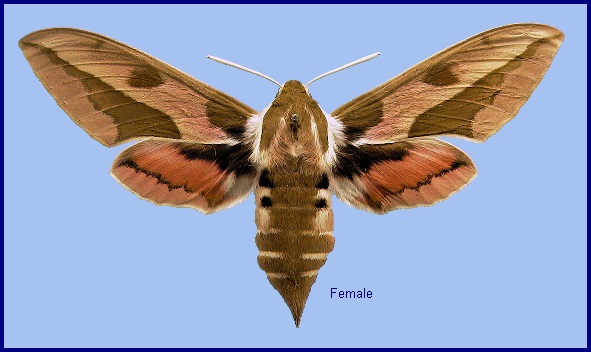
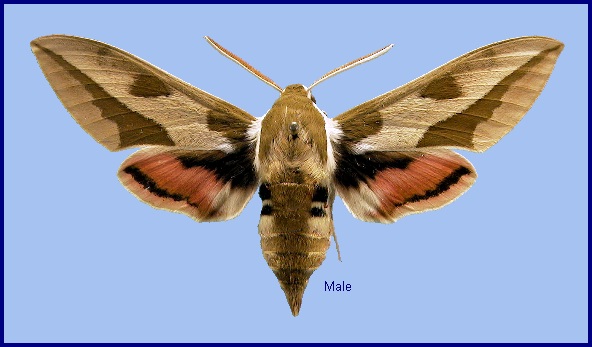
Sphinx euphorbiae Linnaeus, 1758, Syst. Nat. (Edn 10) 1: 492. Type locality: not stated [Sweden].
Synonym. Sphinx euphorbiae Linnaeus, 1758.
Synonym. Sphinx esulae Hufnagel, 1766, Berlin. Mag. 2: 180.
Homonym. Deilephila esulae Boisduval, 1834, Icones hist. Lepid. 2: 26.
Synonym. Deilephila euphorbiae paralias Nickerl, 1837, Boehm. Tag.: 22.
Synonym. Deilephila euphorbiae grentzenbergi Staudinger, 1885, Ent. Nachr. Berlin 11: 10.
Synonym. Celerio euphorbiae vandalusica Ribbe, 1910, Dt. ent. Z. Iris 23: 212.
Synonym. Celerio euphorbiae etrusca Verity, 1911, Boll. Soc. ent. ital. 42: 278.
Synonym. Celerio euphorbiae sinensis Closs, 1917.
Synonym. Celerio euphorbiae strasillai Stauder, 1921, Dt. ent. Z. Iris 35: 31.
Synonym. Celerio euphorbiae rothschildi Stauder, 1928, Lepid. Rdsch. 2: 113.
Synonym. Celerio euphorbiae subiacensis Dannehl, 1929, Mitt. münch. ent. Ges. 19: 99.
Synonym. Celerio euphorbiae dolomiticola Stauder, 1930, Ent. Z., Frankf. a. M. 43: 268.
Synonym. Celerio euphorbiae filapjewi O. Bang-Haas, 1936, Ent. Z., Frankf. a. M. 50: 255.
Synonym. Celerio euphorbiae lucida Derzhavets, 1980, Ent. Obozr. 59: 349.
Note. These are the main synonyms. There are 101 in total, mainly forms and subspecies, which are too many to be listed here.
Wingspan: 70--85mm. Very similar to the other subspecies and to Hyles centralasiae and Hyles nicaea. Normal specimens of each are illustrated in Pittaway (1993) but, due to the great wing-pattern variation exhibited by Hyles euphorbiae euphorbiae, some confusion may arise. Such variation includes wings with no trace of red; wings deeply flushed with red (f. grentzenbergi Staudinger); hindwings rust-brown (f. brunnescens Schultz), or yellow (f. lafitolei Thierry-Mieg) in place of the normal red. All other coloration can vary widely, while in the most extreme form the entire forewing is brown with a series of small, cream, dagger-like markings replacing the oblique median stripe (f. restricta Jordan).
Many Chinese individuals are heavily spotted in a manner similar to Hyles nicaea sheljuzkoi Dublitzky, 1928 (Pittaway & Kitching, 2000).
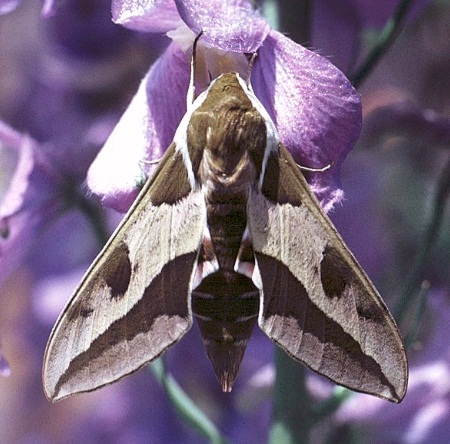
Can be very common in warm, dry years but very scarce in cold, wet ones. Found where perennial herbaceous Euphorbia species are present, with open, sunny locations being preferred, such as along the edges of fields and woodland, and on mountain-sides.
By day, most individuals rest on stones, low walls, amongst low vegetation, or even on the ground, taking flight just after dusk for a short period and again later, in three or four bouts of activity which, in the males at least, usually cease by midnight. It is during one of these that pairing takes place, usually four to five days after emergence and usually between 22.00 and 24.00 hours in Europe (Harbich, 1994), although Friedrich (1975, 1982, 1986) quotes 21.00--23.00 hours. The pair remain in copula for up to three hours. Following separation, females begin oviposition almost immediately, laying a few eggs on the first night and more on subsequent nights. Although this species is attracted to flowers and feeds avidly from many species, few come to light.
China: v-vi (Yining/Gulja); 24.v (Tian Shan); 16.vi (near Shihezi); 27.vii (Beitun); 1.viii (Tian Shan); 21.viii (Korla). Mongolia: 7-11.vi (Khovd Province); 15-18.vi (Gov'-Altai Province); 19.vii (Khovd Province); Russia: 29.vi (Siberia); 9.vii (Altai); 24.viii (Altai).
OVUM: Blue-green, almost spherical (1.0 x 1.1mm), shiny and smooth. Deposited either singly or in small clusters at the tip of a shoot of the hostplant, hatching about ten days later. Interestingly, the eggs of this species are extremely hard; if dropped on to a hard surface they will rebound to a considerable height.
LARVA: Full-fed 70--80mm. Polychromatic.
The newly-hatched larva measures approximately 4mm and is off-white with a black head and horn. With feeding, this primary colour is soon replaced by dark olive black which then lightens with further feeding. At this stage it rests low down on the hostplant during the day, at dusk moving up the stem to feed during darkness in the company of others. After the first moult, the characteristic bright pattern appears, superimposed on a now light greenish yellow-brown background. With each successive moult this becomes more startling until, eventually, the fully-grown larva can feed quite openly, relying on its aposematic coloration for protection. Although the basic pattern remains the same, size and colour are just as variable in the larva as in the adult insect. The dorso-lateral line of eye-spots may be red, yellow, green, white or orange, set in a ground colour which varies from green through light yellowish brown to black.
At all stages, its feeding powers are prodigious. Vast quantities of leaves and also soft stems are consumed between spells of basking, which it does more frequently as it grows. If disturbed, a thick stream of dark green fluid is ejected from the mouth towards the attacker, accompanied by violent body twitching from side to side. Prior to pupation, the larva is very active and wanders a great distance at a very fast pace, finally pupating a considerable way from the hostplant.
The larvae are very sensitive to photoperiod and temperature, and will not go into diapause if exposed to long-day conditions of 17 hours light and 7 hours darkness and >18°C (Harbich, 1976b).
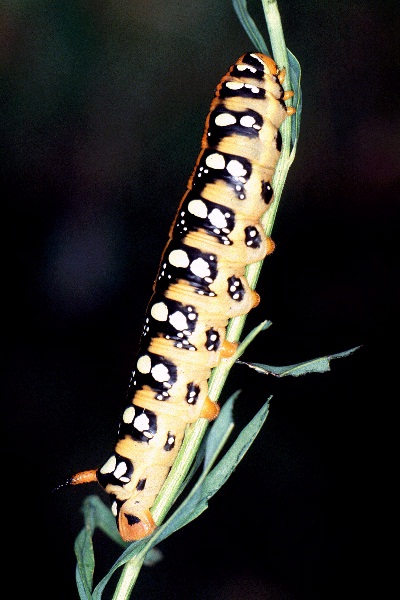
PUPA: 45--50mm. Light yellowish brown with fine, dark striations. Formed within a loosely spun, net-like cocoon, incorporating leaves, soil and other debris, on the surface of the soil. The time spent in this stage can vary considerably -- from two weeks to two years. Overwinters as pupa.
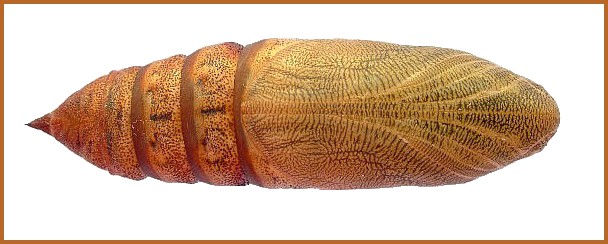
Larval hostplants. Unknown in China but recorded elsewhere on numerous species of Euphorbia (Pittaway, 1995), with occasional records on Onagraceae, Polygonaceae and Vitaceae.
Unknown for the region.
China: Xinjiang (Altai Mountains; Beitun; Jinghe; Korla; Shihezi area; Tian Shan; Yining/Gulja; Xiaerxili Natural Reserve, near Bole City, Bortala Mongol Autonomous Prefecture).
Mongolia: Khovd Province (Bodonchiyn River valley, Elkhony-Ekhen-Tal, 1200m (45°43'N 92°05'E); Bodonchiyn River basin, Hundijn River valley, 1600m (46°06'N 92°30'E); Bulgan River valley, 45km N Bulgan, 1500m); Gov'-Altai Province (Mogoin River, south of Zuyl, 1920m (45°39'N 93°47'E)).
Russia: Siberia (Kolpashevo; Korolevka; Novosibirsk area; Karasuk; Grjady, Krasnoyarsk area); Altai (Rubtsovsk; Barnaul area; Mamontovo; Krasnoshchekovo).
From western Europe (Portugal (Corley, 2004)), and southern and central Europe to the Urals (Kumakov, 1977; Nupponen & Fibiger, 2002), southern western Siberia (Zolotarenko, Petrova & Shiryaev, 1978; Izerskiy, 1999; Dubatolov, pers. comm. 2010; Knyazev, 2020; Maksimov et al., 2022), and the western and southern fringes of the Altai Mountains (Izerskiy, 1999; Saldaitis & Ivinskis, 2006). Also, northern Turkey (Daniel, 1939; de Freina, 1979), the Republic of Georgia, Armenia and Azerbaijan (Didmanidze, Petrov & Zolotuhin, 2013; Streltzov et al., 2022), southeastern Kazakhstan (Shovkoon, 2015; Toropov, Milko, Zhdanko & Evdoshenko, 2023), eastern Uzbekistan (Shermatov et al., 2021; Toropov, Milko, Zhdanko & Evdoshenko, 2023; Omonov, Rahimov, Askarova & Khomidova, 2023); Kyrgyzstan (S. Toropov, pers. comm.; Korb, 2018; Toropov, Milko, Zhdanko & Evdoshenko, 2023), northeastern Afghanistan (Ebert, 1969), northern Pakistan (Rafi et al., 2014), the western Tian Shan (Alpheraky, 1882; Derzhavets, 1980), the eastern Tian Shan (Bang-Haas, 1936) and much of western China (Xinjiang Province (Pittaway & Kitching, 2000), and southwestern Mongolia (Saldaitis & Ivinskis, 2006).
Also, introduced into many areas of the U.S.A. and Canada to control non-native pest species of Euphorbia (Hodges, 1971; Batra, 1983). It is particularly common in Montana, Alberta and Ontario, and has spread as far west as Spokane, Washington State (Carl Barrentine, pers. comm. 2022).
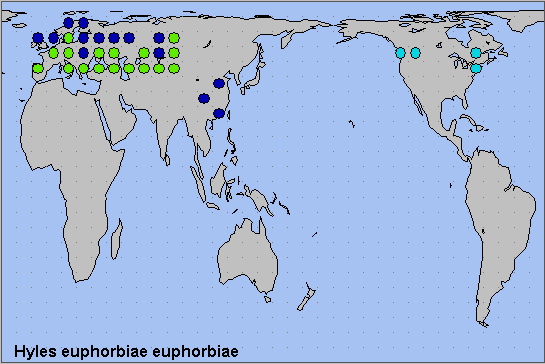
Holarctic; western Palaearctic region. Pleistocene refuge: Polycentric -- Atlantomediterranean, Adriatomediterranean and Pontomediterranean subsections of the Mediterranean refuge, and the Caspian and Iranian refugia. Probably also several of the adjacent eremic refugia.
 Return to Sphingidae of the Eastern Palaearctic species list
Return to Sphingidae of the Eastern Palaearctic species list